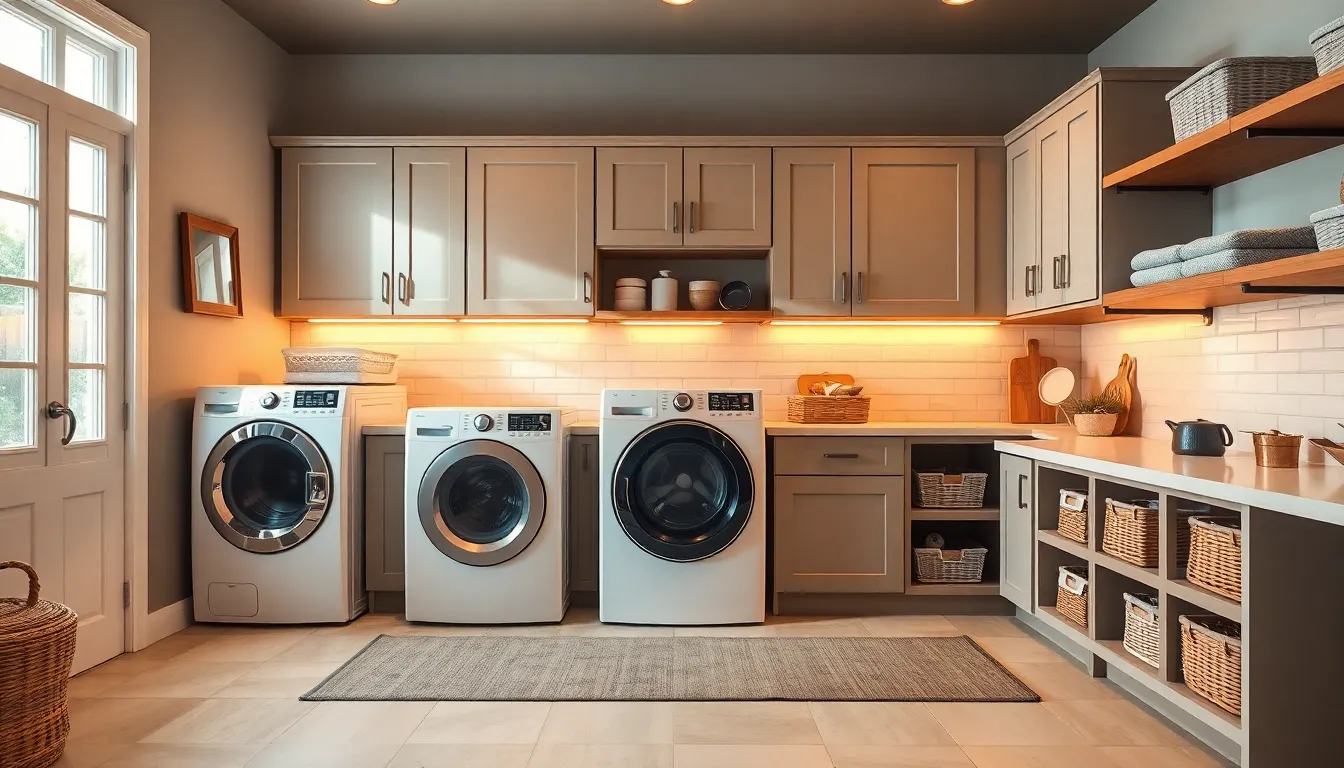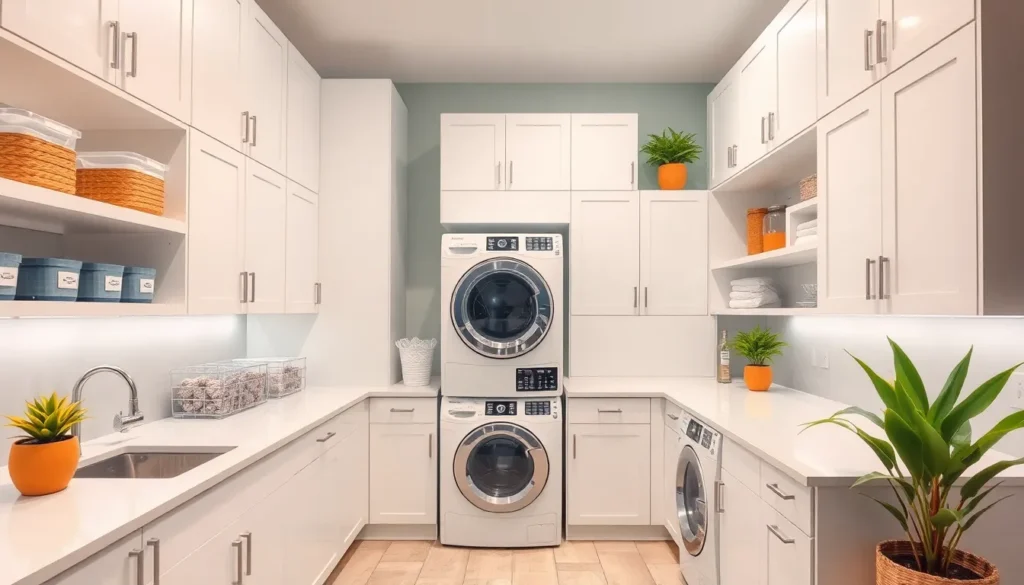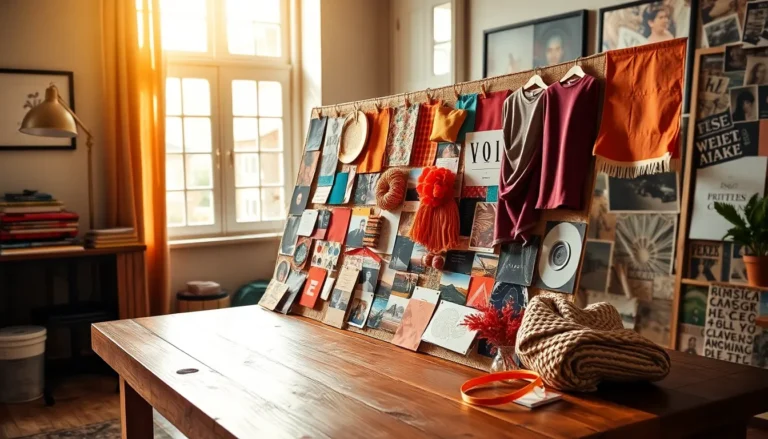Table of Contents
ToggleLaundry rooms often get a bad rap. They’re the forgotten corners of the home, where socks go to disappear and detergent bottles gather dust. But what if this utilitarian space could transform into a stylish sanctuary? Imagine a laundry room so inviting that doing chores feels less like a chore and more like a mini spa day—minus the cucumber slices, of course.
Importance Of Laundry Room Design
Effective laundry room design enhances functionality and elevates aesthetics. A well-planned space maximizes efficiency, making laundry tasks quicker and more organized. Thoughtful organization, such as smart storage solutions, allows easy access to necessities like detergents and fabric softeners.
Style brings joy to daily routines. Incorporating attractive elements like color schemes, lighting, and decor can transform a monotonous area into a pleasant environment. A visually appealing laundry room creates a more enjoyable atmosphere, helping one feel relaxed during chores.
Functionality plays a critical role in utility. When designing, consider incorporating counters for folding and sorting clothes. Well-designed laundry areas may include deep sinks for hand-washing items, making it easier to manage delicate items and repairs.
Comfort also matters. Ergonomic features, like raised washers and dryers, reduce strain during use. This adjustment not only reduces physical fatigue but also promotes a positive mindset towards laundry chores.
Flexibility in design can cater to personal lifestyles. Like incorporating multi-functional spaces, laundry rooms can serve as hubs for pet care or gardening tasks. This adaptability enhances the overall purpose and prevents the area from feeling restricted.
Lastly, investing in thoughtful laundry room design increases the property’s resale value. Homebuyers appreciate well-appointed spaces that reflect care and creativity. For homeowners, this investment means functionality meets aesthetic appeal, creating an inviting and efficient environment.
Key Elements Of Laundry Room Design

Effective laundry room design hinges on key elements that enhance both functionality and style. Prioritizing an organized space translates to a more enjoyable laundry experience.
Layout Considerations
When planning a laundry room, consider factors like traffic flow and workflow efficiency. Positioning appliances near each other minimizes unnecessary movement. Incorporating dedicated areas for folding, sorting, and ironing streamlines tasks. A spacious layout allows for ease of movement, even in smaller rooms. Optimizing corner spaces with stacked washer-dryer units can maximize floor area.
Storage Solutions
Effective storage solutions play a crucial role in maintaining an orderly laundry space. Cabinets, shelves, and baskets provide designated spots for detergent, fabric softener, and other essentials. Incorporating pull-out racks and built-in hampers keep items organized and accessible. Overhead storage takes advantage of vertical space, allowing for greater efficiency. Additionally, labeled containers simplify locating specific items quickly.
Color Schemes And Materials
Color schemes influence the ambiance of a laundry room significantly. Neutral shades create a calming environment, while bold colors add personality. Selecting durable materials, such as laminate or tile, enhances longevity and ease of cleaning. Combining textures, like adding wooden elements with polished surfaces, offers visual interest. Implementing good lighting showcases these color choices and encourages a lively atmosphere.
Functional Features To Include
Creating a functional laundry room involves integrating essential appliances, fixtures, and effective lighting.
Appliances And Fixtures
Upgrading appliances enhances laundry efficiency. Consider energy-efficient washers and dryers that reduce utility costs. Front-loading machines save space and offer better washing results. A deep sink accommodates hand-washing delicate items. Additionally, installing countertop space beside your washer and dryer streamlines folding and sorting. Select fixtures with user-friendly designs to minimize physical strain. Incorporating storage solutions like cabinets or open shelving near appliances creates an organized space. Choose durable materials for surfaces to withstand frequent use. Functional features also include drying racks and hampers in accessible locations to simplify the laundry process.
Lighting Options
Lighting plays a crucial role in laundry room design. Choosing bright, energy-efficient LED lights improves visibility. Task lighting above work surfaces enhances functionality while ambient lighting creates a welcoming atmosphere. Incorporate a dimmer switch to adjust the brightness based on the task at hand. Natural light through windows or skylights can reduce reliance on artificial lighting. Installing under-cabinet lighting illuminates dark corners and makes everything easier to find. Select fixtures that complement the room’s aesthetic, blending functionality with style. Proper lighting not only enhances the room’s appeal but also contributes to a more enjoyable laundry experience.
Tips For Maximizing Space
Maximizing space in a laundry room requires strategic planning and creative solutions. Utilize vertical space by installing wall-mounted shelves and cabinets. Incorporating a folding surface that can hide away when not in use helps maintain an uncluttered look.
Consider stacking appliances to free up floor space, allowing for additional storage or organizational units. Organizing laundry supplies in labeled containers under countertops keeps everything within reach while minimizing visual clutter.
Incorporate multi-functional furniture, like a bench that also serves as a storage box for laundry essentials. Positioning baskets or bins for sorting clothes close to the washer facilitates an efficient workflow.
A pull-out table can provide extra workspace for folding or sorting, ensuring it doesn’t take up permanent space. Integrating hooks for hanging clothes or tools helps in utilizing wall space effectively.
Opt for a narrow cart or rolling storage unit that can slide between appliances or into corners, ensuring access without sacrificing space. Choosing stackable baskets for sorting clean and dirty clothes can also maximize vertical space.
Lighting plays a crucial role in perceiving space; bright, energy-efficient lights can make the area feel larger and more inviting. Selecting light colors for walls and cabinetry enhances the feeling of openness.
Enticing decor, like framed artwork or a colorful rug, can transform the area into an aesthetically pleasing environment while maintaining functionality. Opt for durable, moisture-resistant materials to ensure longevity and easy maintenance.
These tips facilitate a well-organized laundry room design while enhancing overall efficiency and enjoyment in completing laundry tasks.
Transforming a laundry room into a stylish and functional space can significantly enhance the overall experience of doing laundry. By focusing on effective design elements and smart storage solutions, homeowners can create an inviting atmosphere that reduces the monotony of chores.
Incorporating features like dedicated folding areas and energy-efficient appliances not only boosts efficiency but also adds value to the home. With thoughtful planning and attention to detail, the laundry room can become a multi-functional space that reflects personal style while serving practical needs. Embracing this often-overlooked area paves the way for a more enjoyable and organized laundry experience.




